Macquarie University ECON111: Operation Barga Economic Analysis Report
VerifiedAdded on 2022/10/17
|11
|2830
|16
Report
AI Summary
This report examines Operation Barga, a land reform implemented in West Bengal, India, focusing on its economic implications. The assignment analyzes the sharecropping system, where farmers (bargadars) rented land from landowners and shared their crop. Operation Barga aimed to improve farmer incomes and agricultural output by allowing farmers to keep a larger share of their harvest and providing them with protection from eviction. The report explores how this policy impacted Pareto improvement, efficiency, and the trade-offs faced by farmers. It discusses the changes in the relationship between landowners and farmers, the increase in production, and the overall economic growth in the agricultural sector. The analysis also includes an examination of the trade-off between production and free time faced by a farmer, demonstrating the impact of the policy on their choices and utility. The report highlights the successes and limitations of Operation Barga, providing a comprehensive overview of its economic significance.
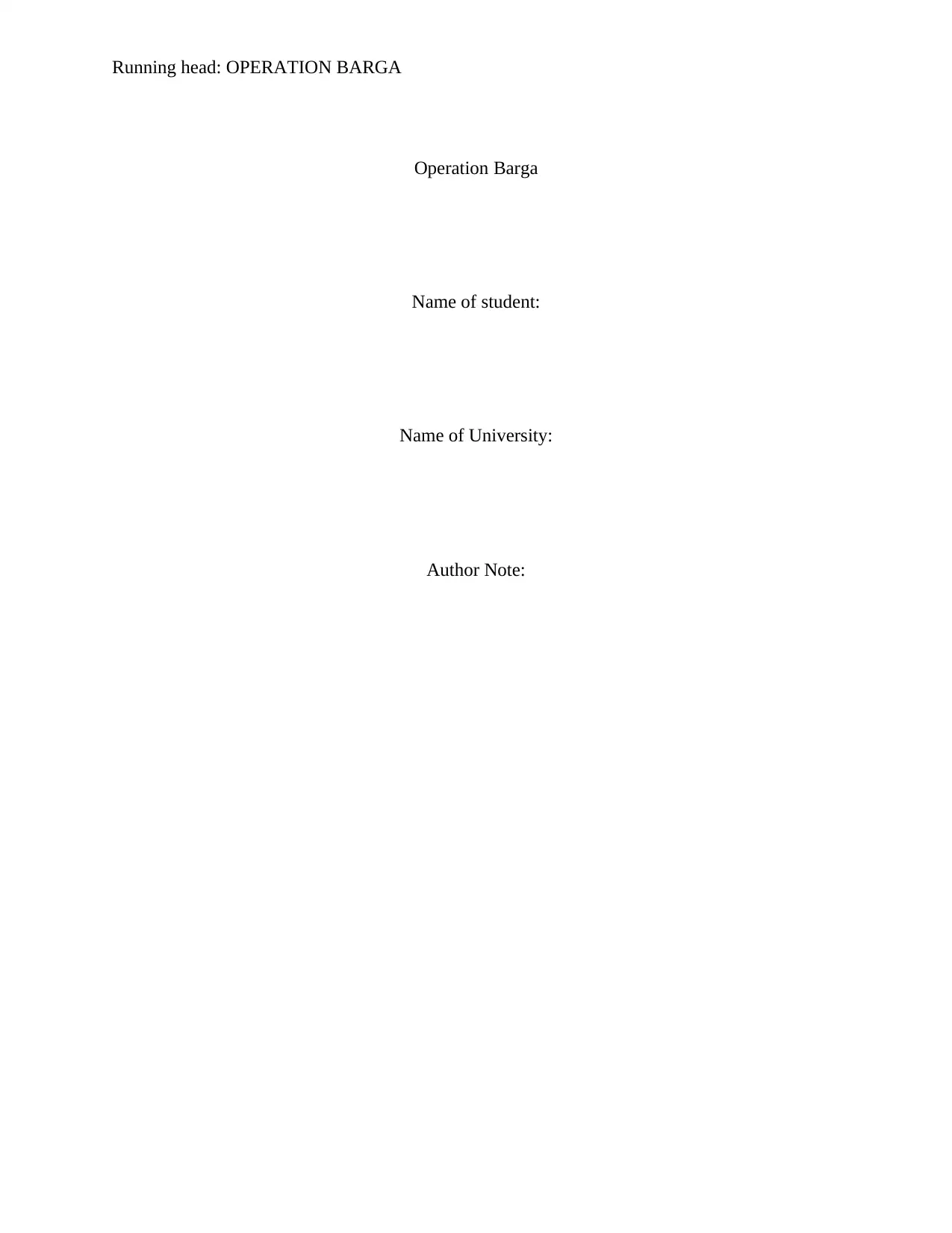
Running head: OPERATION BARGA
Operation Barga
Name of student:
Name of University:
Author Note:
Operation Barga
Name of student:
Name of University:
Author Note:
Secure Best Marks with AI Grader
Need help grading? Try our AI Grader for instant feedback on your assignments.
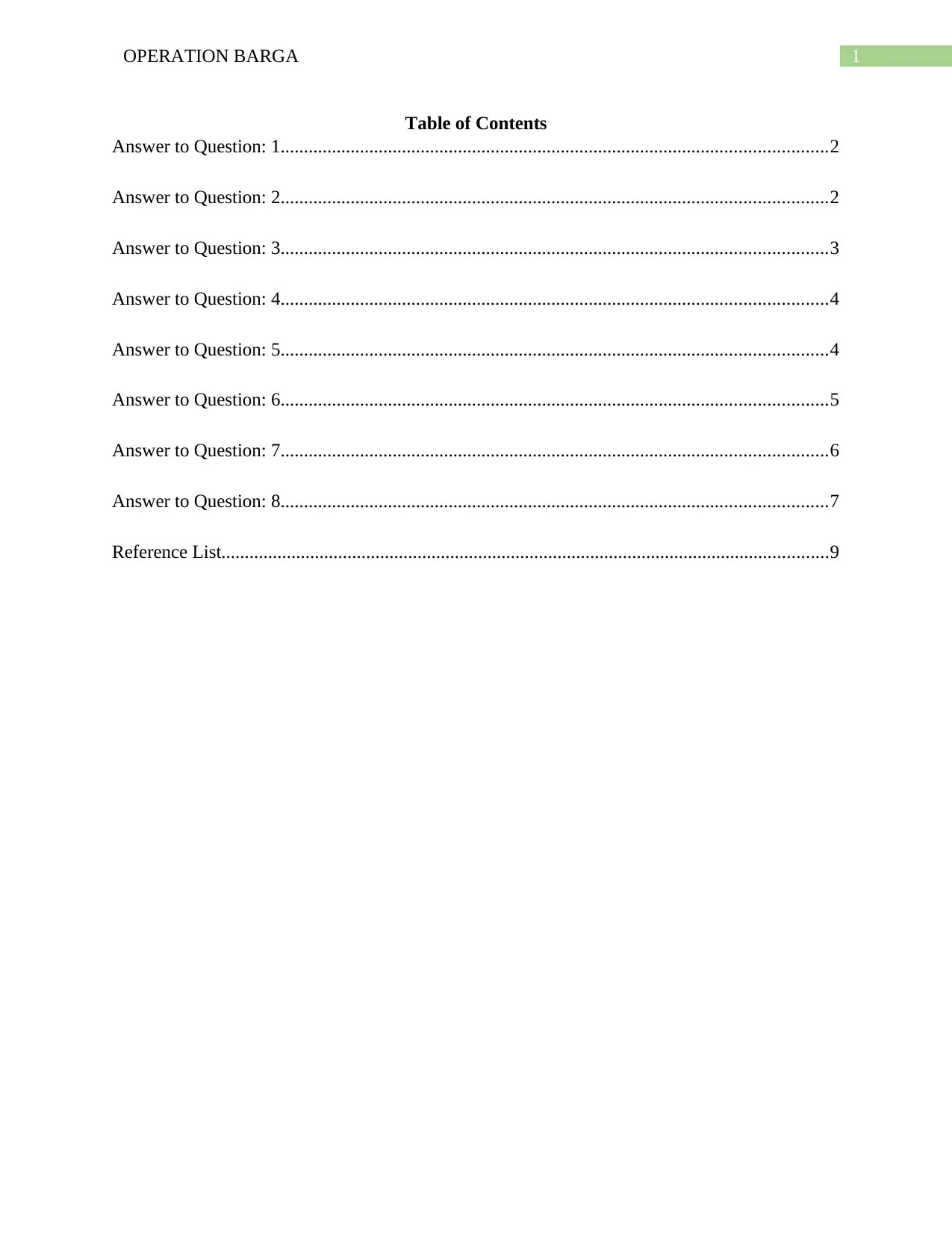
1OPERATION BARGA
Table of Contents
Answer to Question: 1.....................................................................................................................2
Answer to Question: 2.....................................................................................................................2
Answer to Question: 3.....................................................................................................................3
Answer to Question: 4.....................................................................................................................4
Answer to Question: 5.....................................................................................................................4
Answer to Question: 6.....................................................................................................................5
Answer to Question: 7.....................................................................................................................6
Answer to Question: 8.....................................................................................................................7
Reference List..................................................................................................................................9
Table of Contents
Answer to Question: 1.....................................................................................................................2
Answer to Question: 2.....................................................................................................................2
Answer to Question: 3.....................................................................................................................3
Answer to Question: 4.....................................................................................................................4
Answer to Question: 5.....................................................................................................................4
Answer to Question: 6.....................................................................................................................5
Answer to Question: 7.....................................................................................................................6
Answer to Question: 8.....................................................................................................................7
Reference List..................................................................................................................................9
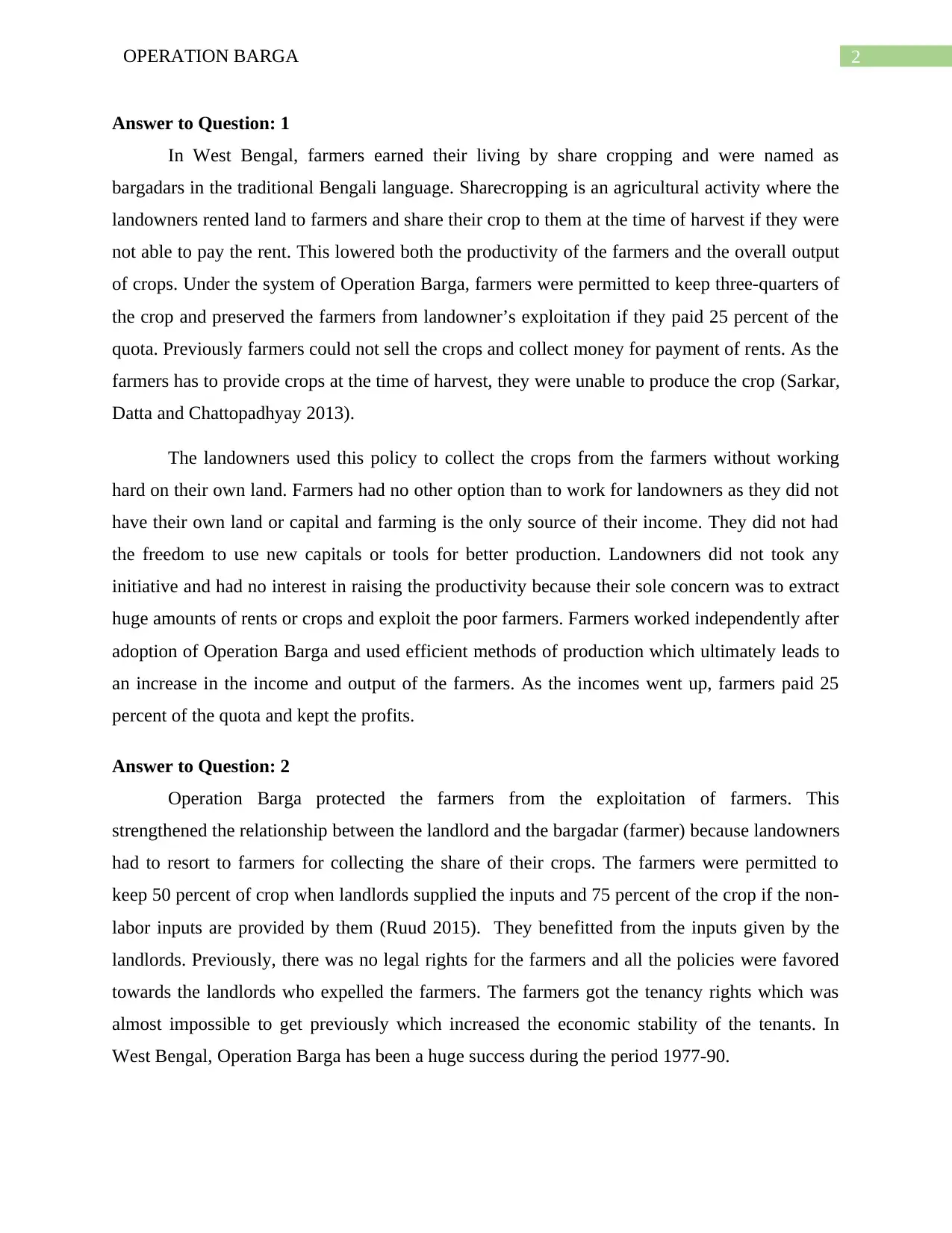
2OPERATION BARGA
Answer to Question: 1
In West Bengal, farmers earned their living by share cropping and were named as
bargadars in the traditional Bengali language. Sharecropping is an agricultural activity where the
landowners rented land to farmers and share their crop to them at the time of harvest if they were
not able to pay the rent. This lowered both the productivity of the farmers and the overall output
of crops. Under the system of Operation Barga, farmers were permitted to keep three-quarters of
the crop and preserved the farmers from landowner’s exploitation if they paid 25 percent of the
quota. Previously farmers could not sell the crops and collect money for payment of rents. As the
farmers has to provide crops at the time of harvest, they were unable to produce the crop (Sarkar,
Datta and Chattopadhyay 2013).
The landowners used this policy to collect the crops from the farmers without working
hard on their own land. Farmers had no other option than to work for landowners as they did not
have their own land or capital and farming is the only source of their income. They did not had
the freedom to use new capitals or tools for better production. Landowners did not took any
initiative and had no interest in raising the productivity because their sole concern was to extract
huge amounts of rents or crops and exploit the poor farmers. Farmers worked independently after
adoption of Operation Barga and used efficient methods of production which ultimately leads to
an increase in the income and output of the farmers. As the incomes went up, farmers paid 25
percent of the quota and kept the profits.
Answer to Question: 2
Operation Barga protected the farmers from the exploitation of farmers. This
strengthened the relationship between the landlord and the bargadar (farmer) because landowners
had to resort to farmers for collecting the share of their crops. The farmers were permitted to
keep 50 percent of crop when landlords supplied the inputs and 75 percent of the crop if the non-
labor inputs are provided by them (Ruud 2015). They benefitted from the inputs given by the
landlords. Previously, there was no legal rights for the farmers and all the policies were favored
towards the landlords who expelled the farmers. The farmers got the tenancy rights which was
almost impossible to get previously which increased the economic stability of the tenants. In
West Bengal, Operation Barga has been a huge success during the period 1977-90.
Answer to Question: 1
In West Bengal, farmers earned their living by share cropping and were named as
bargadars in the traditional Bengali language. Sharecropping is an agricultural activity where the
landowners rented land to farmers and share their crop to them at the time of harvest if they were
not able to pay the rent. This lowered both the productivity of the farmers and the overall output
of crops. Under the system of Operation Barga, farmers were permitted to keep three-quarters of
the crop and preserved the farmers from landowner’s exploitation if they paid 25 percent of the
quota. Previously farmers could not sell the crops and collect money for payment of rents. As the
farmers has to provide crops at the time of harvest, they were unable to produce the crop (Sarkar,
Datta and Chattopadhyay 2013).
The landowners used this policy to collect the crops from the farmers without working
hard on their own land. Farmers had no other option than to work for landowners as they did not
have their own land or capital and farming is the only source of their income. They did not had
the freedom to use new capitals or tools for better production. Landowners did not took any
initiative and had no interest in raising the productivity because their sole concern was to extract
huge amounts of rents or crops and exploit the poor farmers. Farmers worked independently after
adoption of Operation Barga and used efficient methods of production which ultimately leads to
an increase in the income and output of the farmers. As the incomes went up, farmers paid 25
percent of the quota and kept the profits.
Answer to Question: 2
Operation Barga protected the farmers from the exploitation of farmers. This
strengthened the relationship between the landlord and the bargadar (farmer) because landowners
had to resort to farmers for collecting the share of their crops. The farmers were permitted to
keep 50 percent of crop when landlords supplied the inputs and 75 percent of the crop if the non-
labor inputs are provided by them (Ruud 2015). They benefitted from the inputs given by the
landlords. Previously, there was no legal rights for the farmers and all the policies were favored
towards the landlords who expelled the farmers. The farmers got the tenancy rights which was
almost impossible to get previously which increased the economic stability of the tenants. In
West Bengal, Operation Barga has been a huge success during the period 1977-90.
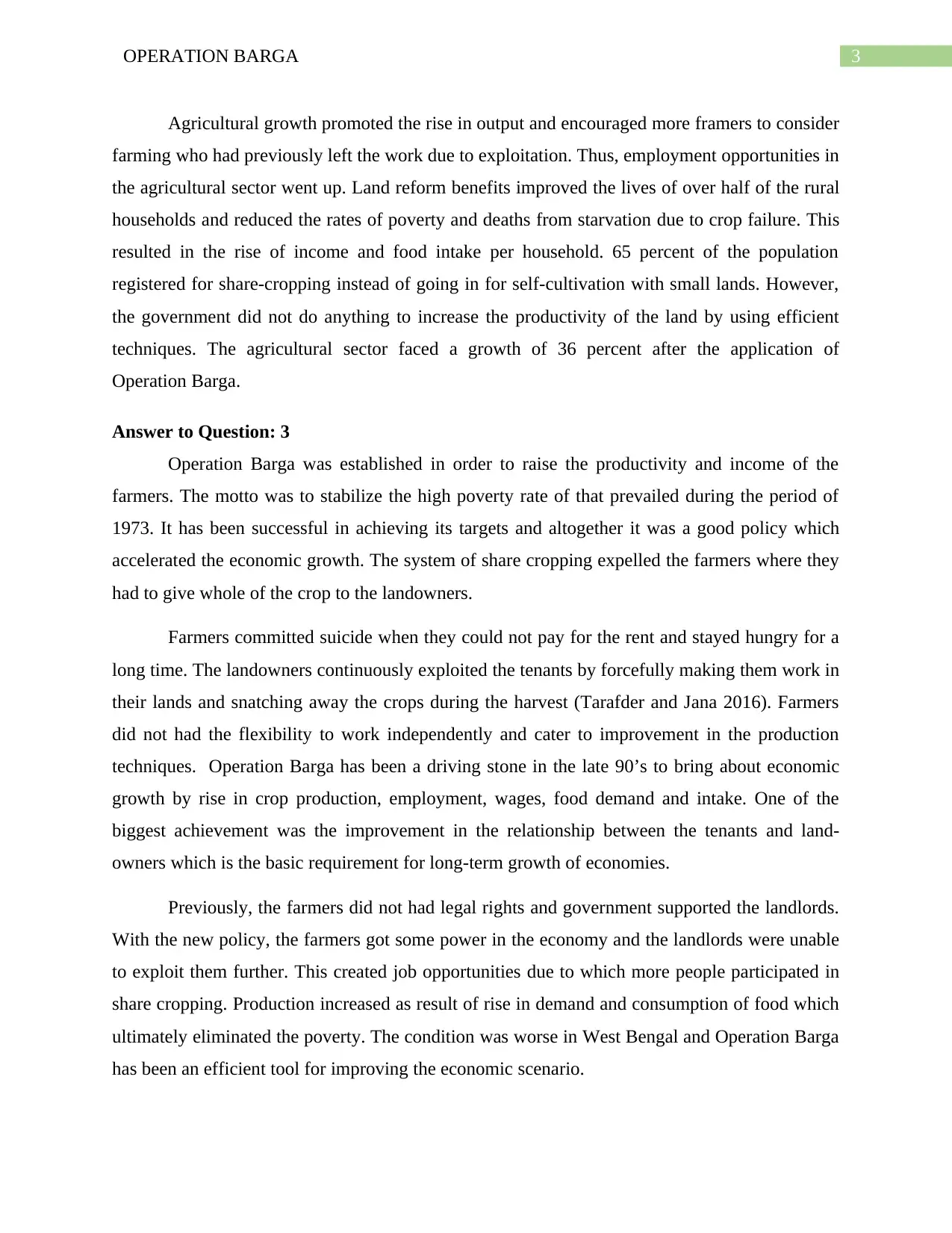
3OPERATION BARGA
Agricultural growth promoted the rise in output and encouraged more framers to consider
farming who had previously left the work due to exploitation. Thus, employment opportunities in
the agricultural sector went up. Land reform benefits improved the lives of over half of the rural
households and reduced the rates of poverty and deaths from starvation due to crop failure. This
resulted in the rise of income and food intake per household. 65 percent of the population
registered for share-cropping instead of going in for self-cultivation with small lands. However,
the government did not do anything to increase the productivity of the land by using efficient
techniques. The agricultural sector faced a growth of 36 percent after the application of
Operation Barga.
Answer to Question: 3
Operation Barga was established in order to raise the productivity and income of the
farmers. The motto was to stabilize the high poverty rate of that prevailed during the period of
1973. It has been successful in achieving its targets and altogether it was a good policy which
accelerated the economic growth. The system of share cropping expelled the farmers where they
had to give whole of the crop to the landowners.
Farmers committed suicide when they could not pay for the rent and stayed hungry for a
long time. The landowners continuously exploited the tenants by forcefully making them work in
their lands and snatching away the crops during the harvest (Tarafder and Jana 2016). Farmers
did not had the flexibility to work independently and cater to improvement in the production
techniques. Operation Barga has been a driving stone in the late 90’s to bring about economic
growth by rise in crop production, employment, wages, food demand and intake. One of the
biggest achievement was the improvement in the relationship between the tenants and land-
owners which is the basic requirement for long-term growth of economies.
Previously, the farmers did not had legal rights and government supported the landlords.
With the new policy, the farmers got some power in the economy and the landlords were unable
to exploit them further. This created job opportunities due to which more people participated in
share cropping. Production increased as result of rise in demand and consumption of food which
ultimately eliminated the poverty. The condition was worse in West Bengal and Operation Barga
has been an efficient tool for improving the economic scenario.
Agricultural growth promoted the rise in output and encouraged more framers to consider
farming who had previously left the work due to exploitation. Thus, employment opportunities in
the agricultural sector went up. Land reform benefits improved the lives of over half of the rural
households and reduced the rates of poverty and deaths from starvation due to crop failure. This
resulted in the rise of income and food intake per household. 65 percent of the population
registered for share-cropping instead of going in for self-cultivation with small lands. However,
the government did not do anything to increase the productivity of the land by using efficient
techniques. The agricultural sector faced a growth of 36 percent after the application of
Operation Barga.
Answer to Question: 3
Operation Barga was established in order to raise the productivity and income of the
farmers. The motto was to stabilize the high poverty rate of that prevailed during the period of
1973. It has been successful in achieving its targets and altogether it was a good policy which
accelerated the economic growth. The system of share cropping expelled the farmers where they
had to give whole of the crop to the landowners.
Farmers committed suicide when they could not pay for the rent and stayed hungry for a
long time. The landowners continuously exploited the tenants by forcefully making them work in
their lands and snatching away the crops during the harvest (Tarafder and Jana 2016). Farmers
did not had the flexibility to work independently and cater to improvement in the production
techniques. Operation Barga has been a driving stone in the late 90’s to bring about economic
growth by rise in crop production, employment, wages, food demand and intake. One of the
biggest achievement was the improvement in the relationship between the tenants and land-
owners which is the basic requirement for long-term growth of economies.
Previously, the farmers did not had legal rights and government supported the landlords.
With the new policy, the farmers got some power in the economy and the landlords were unable
to exploit them further. This created job opportunities due to which more people participated in
share cropping. Production increased as result of rise in demand and consumption of food which
ultimately eliminated the poverty. The condition was worse in West Bengal and Operation Barga
has been an efficient tool for improving the economic scenario.
Secure Best Marks with AI Grader
Need help grading? Try our AI Grader for instant feedback on your assignments.
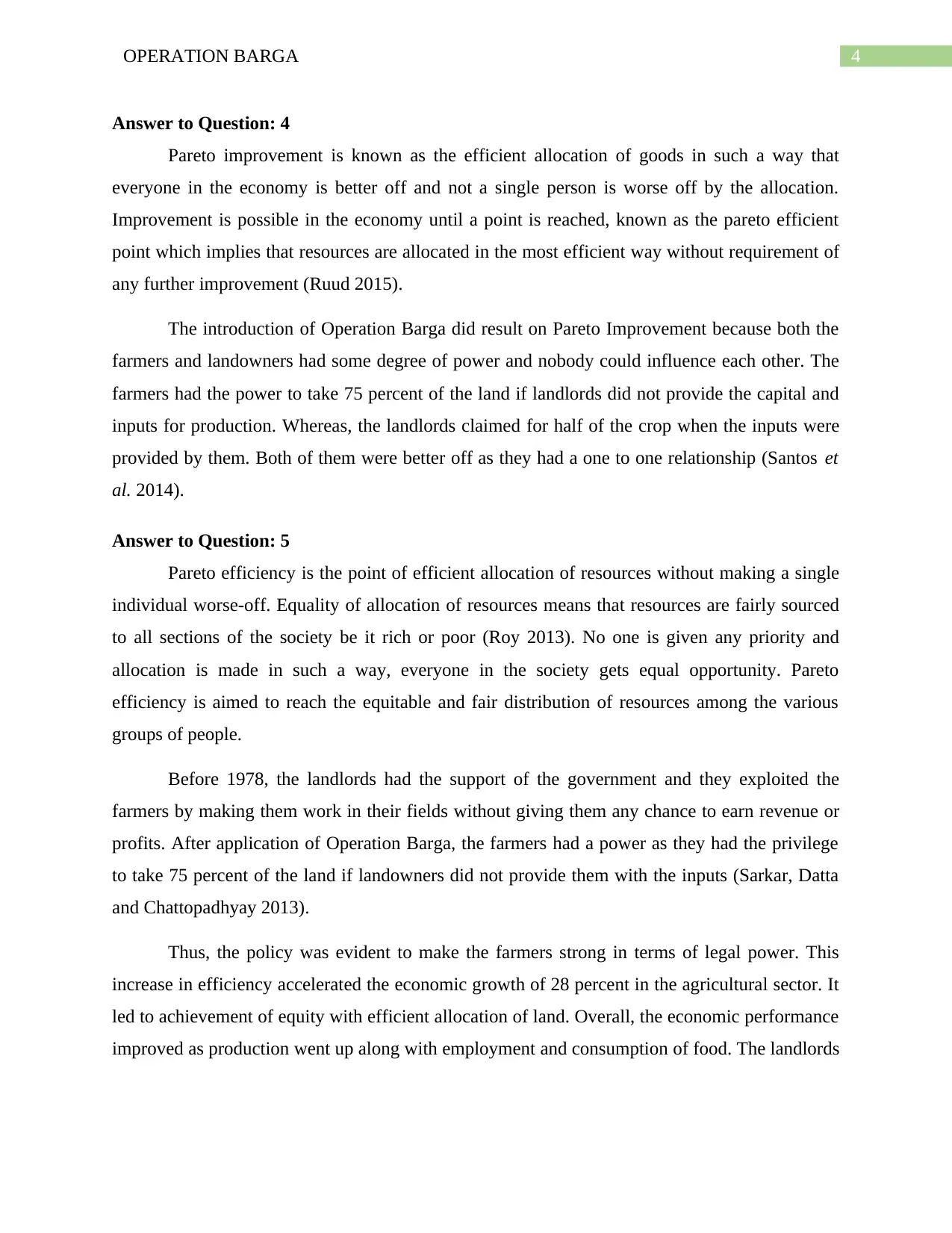
4OPERATION BARGA
Answer to Question: 4
Pareto improvement is known as the efficient allocation of goods in such a way that
everyone in the economy is better off and not a single person is worse off by the allocation.
Improvement is possible in the economy until a point is reached, known as the pareto efficient
point which implies that resources are allocated in the most efficient way without requirement of
any further improvement (Ruud 2015).
The introduction of Operation Barga did result on Pareto Improvement because both the
farmers and landowners had some degree of power and nobody could influence each other. The
farmers had the power to take 75 percent of the land if landlords did not provide the capital and
inputs for production. Whereas, the landlords claimed for half of the crop when the inputs were
provided by them. Both of them were better off as they had a one to one relationship (Santos et
al. 2014).
Answer to Question: 5
Pareto efficiency is the point of efficient allocation of resources without making a single
individual worse-off. Equality of allocation of resources means that resources are fairly sourced
to all sections of the society be it rich or poor (Roy 2013). No one is given any priority and
allocation is made in such a way, everyone in the society gets equal opportunity. Pareto
efficiency is aimed to reach the equitable and fair distribution of resources among the various
groups of people.
Before 1978, the landlords had the support of the government and they exploited the
farmers by making them work in their fields without giving them any chance to earn revenue or
profits. After application of Operation Barga, the farmers had a power as they had the privilege
to take 75 percent of the land if landowners did not provide them with the inputs (Sarkar, Datta
and Chattopadhyay 2013).
Thus, the policy was evident to make the farmers strong in terms of legal power. This
increase in efficiency accelerated the economic growth of 28 percent in the agricultural sector. It
led to achievement of equity with efficient allocation of land. Overall, the economic performance
improved as production went up along with employment and consumption of food. The landlords
Answer to Question: 4
Pareto improvement is known as the efficient allocation of goods in such a way that
everyone in the economy is better off and not a single person is worse off by the allocation.
Improvement is possible in the economy until a point is reached, known as the pareto efficient
point which implies that resources are allocated in the most efficient way without requirement of
any further improvement (Ruud 2015).
The introduction of Operation Barga did result on Pareto Improvement because both the
farmers and landowners had some degree of power and nobody could influence each other. The
farmers had the power to take 75 percent of the land if landlords did not provide the capital and
inputs for production. Whereas, the landlords claimed for half of the crop when the inputs were
provided by them. Both of them were better off as they had a one to one relationship (Santos et
al. 2014).
Answer to Question: 5
Pareto efficiency is the point of efficient allocation of resources without making a single
individual worse-off. Equality of allocation of resources means that resources are fairly sourced
to all sections of the society be it rich or poor (Roy 2013). No one is given any priority and
allocation is made in such a way, everyone in the society gets equal opportunity. Pareto
efficiency is aimed to reach the equitable and fair distribution of resources among the various
groups of people.
Before 1978, the landlords had the support of the government and they exploited the
farmers by making them work in their fields without giving them any chance to earn revenue or
profits. After application of Operation Barga, the farmers had a power as they had the privilege
to take 75 percent of the land if landowners did not provide them with the inputs (Sarkar, Datta
and Chattopadhyay 2013).
Thus, the policy was evident to make the farmers strong in terms of legal power. This
increase in efficiency accelerated the economic growth of 28 percent in the agricultural sector. It
led to achievement of equity with efficient allocation of land. Overall, the economic performance
improved as production went up along with employment and consumption of food. The landlords
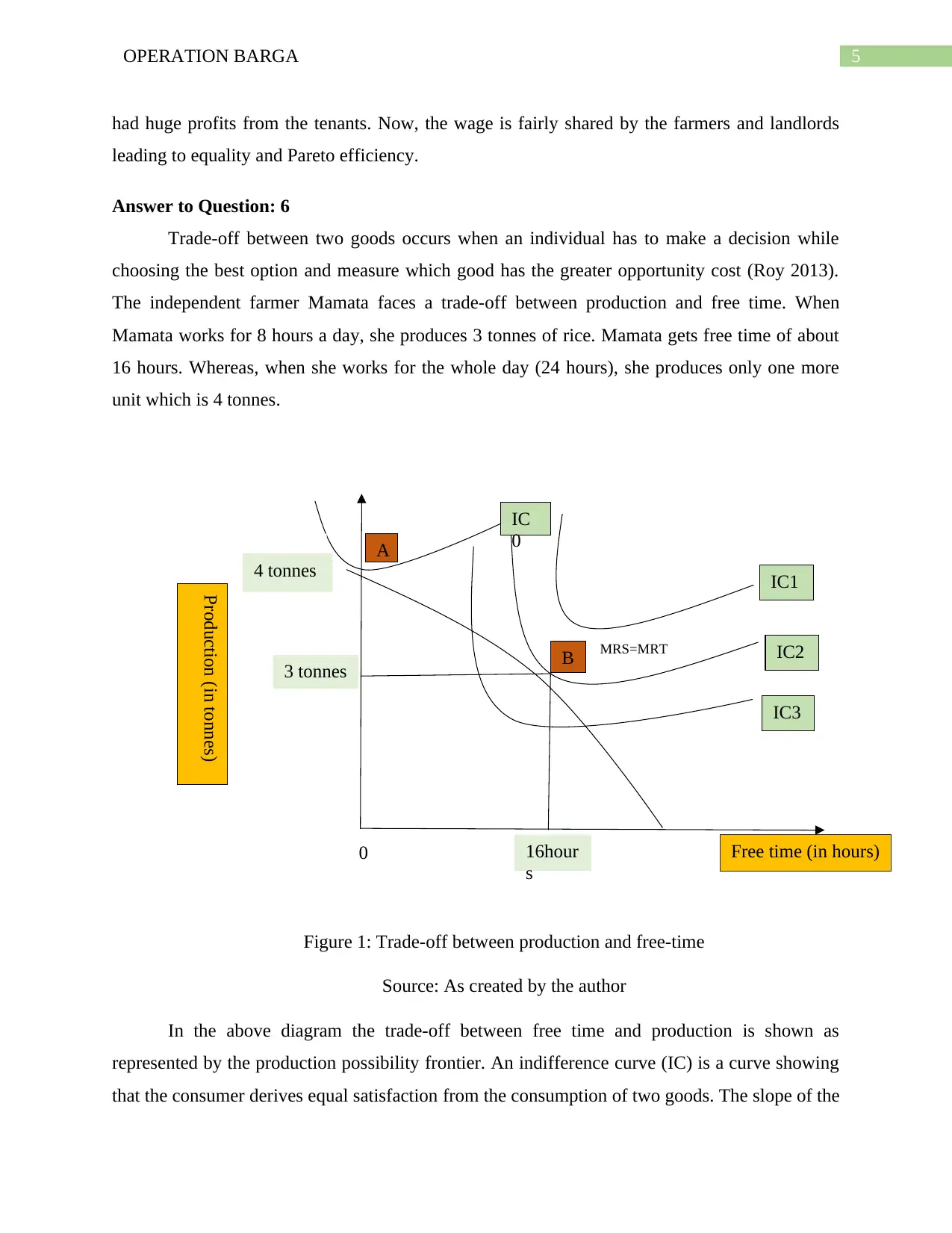
5OPERATION BARGA
Free time (in hours)16hour
s
0
3 tonnes
4 tonnes
Production (in tonnes)
IC
0
IC1
IC2
IC3
B
A
MRS=MRT
had huge profits from the tenants. Now, the wage is fairly shared by the farmers and landlords
leading to equality and Pareto efficiency.
Answer to Question: 6
Trade-off between two goods occurs when an individual has to make a decision while
choosing the best option and measure which good has the greater opportunity cost (Roy 2013).
The independent farmer Mamata faces a trade-off between production and free time. When
Mamata works for 8 hours a day, she produces 3 tonnes of rice. Mamata gets free time of about
16 hours. Whereas, when she works for the whole day (24 hours), she produces only one more
unit which is 4 tonnes.
Figure 1: Trade-off between production and free-time
Source: As created by the author
In the above diagram the trade-off between free time and production is shown as
represented by the production possibility frontier. An indifference curve (IC) is a curve showing
that the consumer derives equal satisfaction from the consumption of two goods. The slope of the
Free time (in hours)16hour
s
0
3 tonnes
4 tonnes
Production (in tonnes)
IC
0
IC1
IC2
IC3
B
A
MRS=MRT
had huge profits from the tenants. Now, the wage is fairly shared by the farmers and landlords
leading to equality and Pareto efficiency.
Answer to Question: 6
Trade-off between two goods occurs when an individual has to make a decision while
choosing the best option and measure which good has the greater opportunity cost (Roy 2013).
The independent farmer Mamata faces a trade-off between production and free time. When
Mamata works for 8 hours a day, she produces 3 tonnes of rice. Mamata gets free time of about
16 hours. Whereas, when she works for the whole day (24 hours), she produces only one more
unit which is 4 tonnes.
Figure 1: Trade-off between production and free-time
Source: As created by the author
In the above diagram the trade-off between free time and production is shown as
represented by the production possibility frontier. An indifference curve (IC) is a curve showing
that the consumer derives equal satisfaction from the consumption of two goods. The slope of the
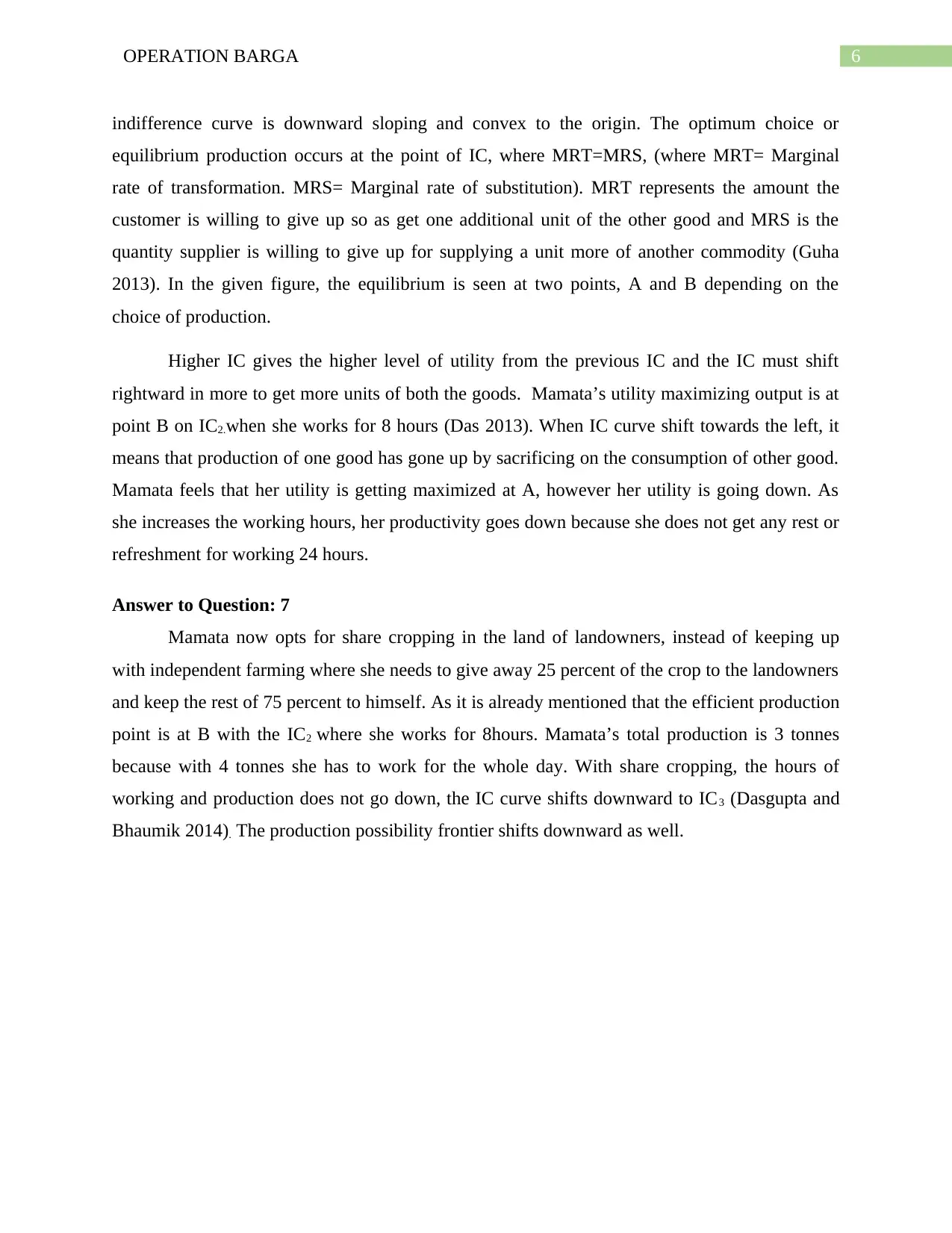
6OPERATION BARGA
indifference curve is downward sloping and convex to the origin. The optimum choice or
equilibrium production occurs at the point of IC, where MRT=MRS, (where MRT= Marginal
rate of transformation. MRS= Marginal rate of substitution). MRT represents the amount the
customer is willing to give up so as get one additional unit of the other good and MRS is the
quantity supplier is willing to give up for supplying a unit more of another commodity (Guha
2013). In the given figure, the equilibrium is seen at two points, A and B depending on the
choice of production.
Higher IC gives the higher level of utility from the previous IC and the IC must shift
rightward in more to get more units of both the goods. Mamata’s utility maximizing output is at
point B on IC2.when she works for 8 hours (Das 2013). When IC curve shift towards the left, it
means that production of one good has gone up by sacrificing on the consumption of other good.
Mamata feels that her utility is getting maximized at A, however her utility is going down. As
she increases the working hours, her productivity goes down because she does not get any rest or
refreshment for working 24 hours.
Answer to Question: 7
Mamata now opts for share cropping in the land of landowners, instead of keeping up
with independent farming where she needs to give away 25 percent of the crop to the landowners
and keep the rest of 75 percent to himself. As it is already mentioned that the efficient production
point is at B with the IC2 where she works for 8hours. Mamata’s total production is 3 tonnes
because with 4 tonnes she has to work for the whole day. With share cropping, the hours of
working and production does not go down, the IC curve shifts downward to IC3 (Dasgupta and
Bhaumik 2014). The production possibility frontier shifts downward as well.
indifference curve is downward sloping and convex to the origin. The optimum choice or
equilibrium production occurs at the point of IC, where MRT=MRS, (where MRT= Marginal
rate of transformation. MRS= Marginal rate of substitution). MRT represents the amount the
customer is willing to give up so as get one additional unit of the other good and MRS is the
quantity supplier is willing to give up for supplying a unit more of another commodity (Guha
2013). In the given figure, the equilibrium is seen at two points, A and B depending on the
choice of production.
Higher IC gives the higher level of utility from the previous IC and the IC must shift
rightward in more to get more units of both the goods. Mamata’s utility maximizing output is at
point B on IC2.when she works for 8 hours (Das 2013). When IC curve shift towards the left, it
means that production of one good has gone up by sacrificing on the consumption of other good.
Mamata feels that her utility is getting maximized at A, however her utility is going down. As
she increases the working hours, her productivity goes down because she does not get any rest or
refreshment for working 24 hours.
Answer to Question: 7
Mamata now opts for share cropping in the land of landowners, instead of keeping up
with independent farming where she needs to give away 25 percent of the crop to the landowners
and keep the rest of 75 percent to himself. As it is already mentioned that the efficient production
point is at B with the IC2 where she works for 8hours. Mamata’s total production is 3 tonnes
because with 4 tonnes she has to work for the whole day. With share cropping, the hours of
working and production does not go down, the IC curve shifts downward to IC3 (Dasgupta and
Bhaumik 2014). The production possibility frontier shifts downward as well.
Paraphrase This Document
Need a fresh take? Get an instant paraphrase of this document with our AI Paraphraser
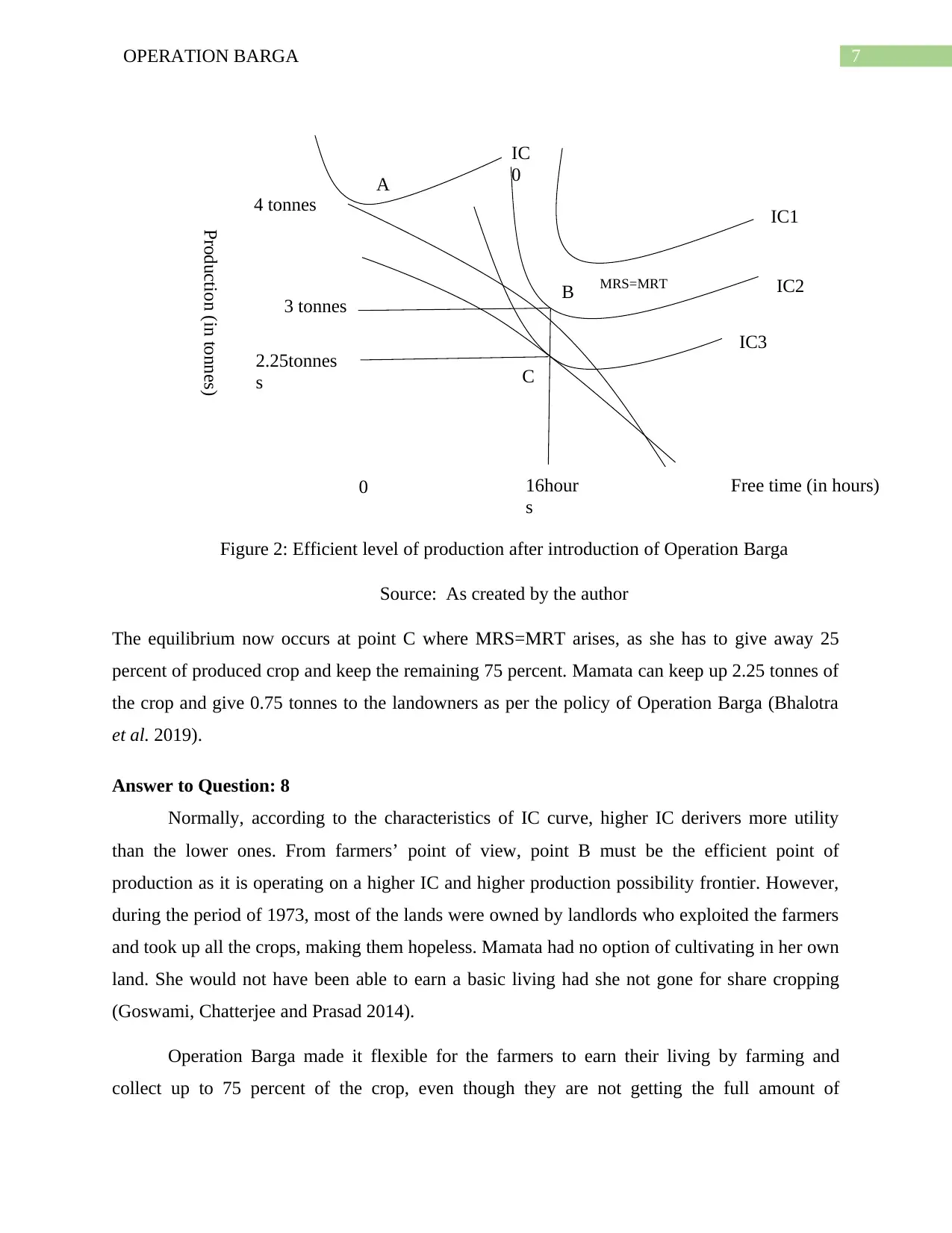
7OPERATION BARGA
Free time (in hours)16hour
s
0
3 tonnes
4 tonnes
Production (in tonnes)
IC
0
IC1
IC2
IC3
B
A
MRS=MRT
2.25tonnes
s C
Figure 2: Efficient level of production after introduction of Operation Barga
Source: As created by the author
The equilibrium now occurs at point C where MRS=MRT arises, as she has to give away 25
percent of produced crop and keep the remaining 75 percent. Mamata can keep up 2.25 tonnes of
the crop and give 0.75 tonnes to the landowners as per the policy of Operation Barga (Bhalotra
et al. 2019).
Answer to Question: 8
Normally, according to the characteristics of IC curve, higher IC derivers more utility
than the lower ones. From farmers’ point of view, point B must be the efficient point of
production as it is operating on a higher IC and higher production possibility frontier. However,
during the period of 1973, most of the lands were owned by landlords who exploited the farmers
and took up all the crops, making them hopeless. Mamata had no option of cultivating in her own
land. She would not have been able to earn a basic living had she not gone for share cropping
(Goswami, Chatterjee and Prasad 2014).
Operation Barga made it flexible for the farmers to earn their living by farming and
collect up to 75 percent of the crop, even though they are not getting the full amount of
Free time (in hours)16hour
s
0
3 tonnes
4 tonnes
Production (in tonnes)
IC
0
IC1
IC2
IC3
B
A
MRS=MRT
2.25tonnes
s C
Figure 2: Efficient level of production after introduction of Operation Barga
Source: As created by the author
The equilibrium now occurs at point C where MRS=MRT arises, as she has to give away 25
percent of produced crop and keep the remaining 75 percent. Mamata can keep up 2.25 tonnes of
the crop and give 0.75 tonnes to the landowners as per the policy of Operation Barga (Bhalotra
et al. 2019).
Answer to Question: 8
Normally, according to the characteristics of IC curve, higher IC derivers more utility
than the lower ones. From farmers’ point of view, point B must be the efficient point of
production as it is operating on a higher IC and higher production possibility frontier. However,
during the period of 1973, most of the lands were owned by landlords who exploited the farmers
and took up all the crops, making them hopeless. Mamata had no option of cultivating in her own
land. She would not have been able to earn a basic living had she not gone for share cropping
(Goswami, Chatterjee and Prasad 2014).
Operation Barga made it flexible for the farmers to earn their living by farming and
collect up to 75 percent of the crop, even though they are not getting the full amount of
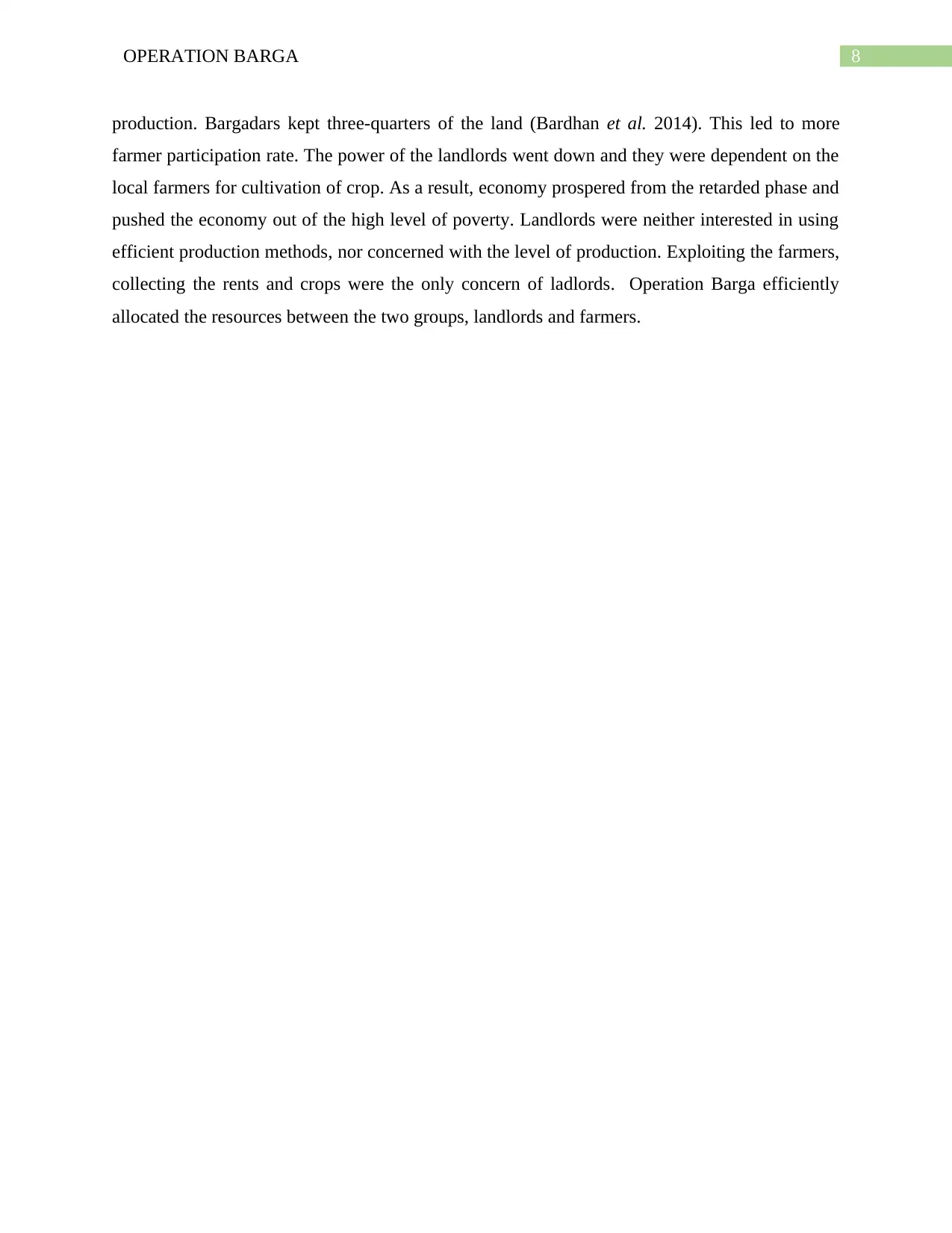
8OPERATION BARGA
production. Bargadars kept three-quarters of the land (Bardhan et al. 2014). This led to more
farmer participation rate. The power of the landlords went down and they were dependent on the
local farmers for cultivation of crop. As a result, economy prospered from the retarded phase and
pushed the economy out of the high level of poverty. Landlords were neither interested in using
efficient production methods, nor concerned with the level of production. Exploiting the farmers,
collecting the rents and crops were the only concern of ladlords. Operation Barga efficiently
allocated the resources between the two groups, landlords and farmers.
production. Bargadars kept three-quarters of the land (Bardhan et al. 2014). This led to more
farmer participation rate. The power of the landlords went down and they were dependent on the
local farmers for cultivation of crop. As a result, economy prospered from the retarded phase and
pushed the economy out of the high level of poverty. Landlords were neither interested in using
efficient production methods, nor concerned with the level of production. Exploiting the farmers,
collecting the rents and crops were the only concern of ladlords. Operation Barga efficiently
allocated the resources between the two groups, landlords and farmers.
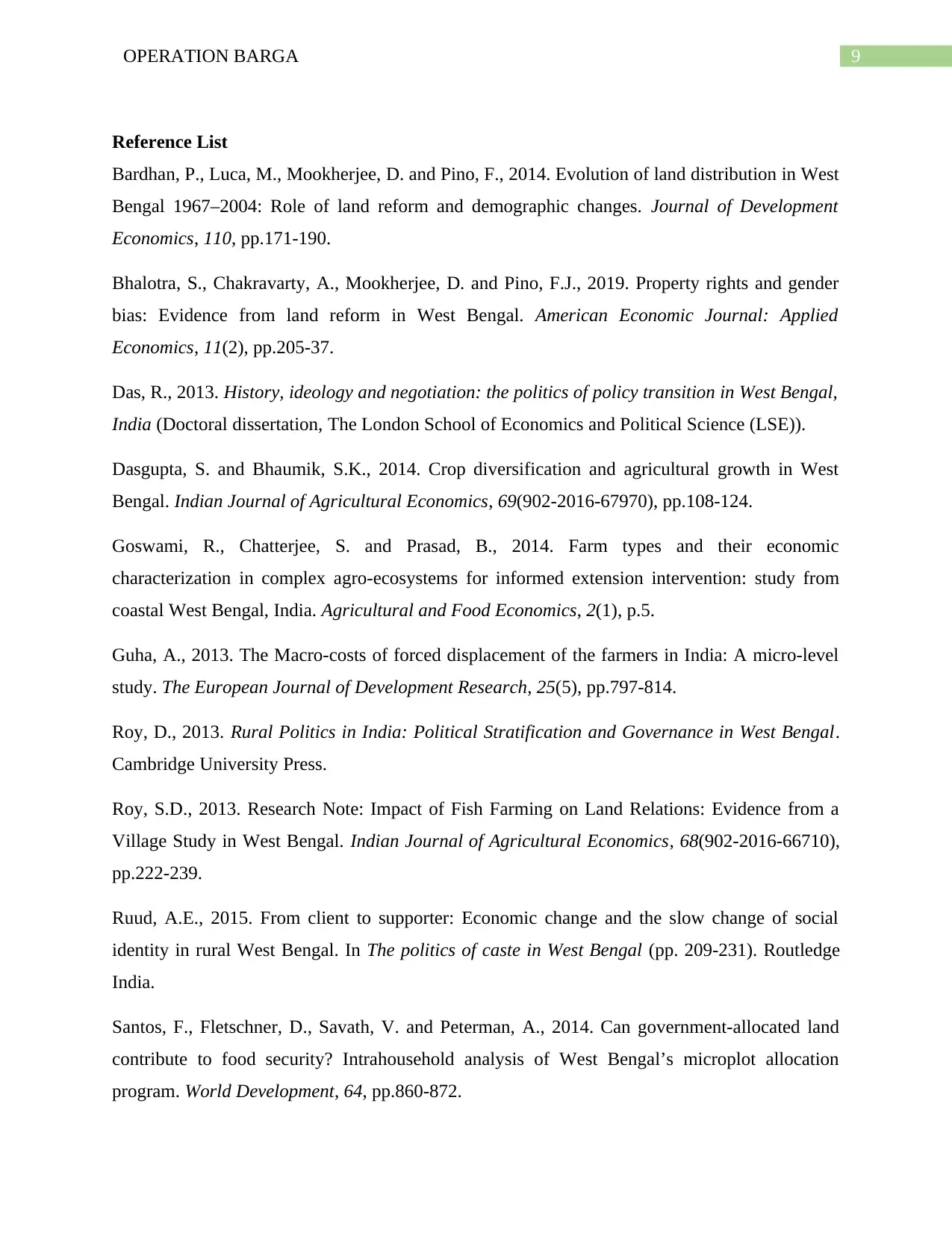
9OPERATION BARGA
Reference List
Bardhan, P., Luca, M., Mookherjee, D. and Pino, F., 2014. Evolution of land distribution in West
Bengal 1967–2004: Role of land reform and demographic changes. Journal of Development
Economics, 110, pp.171-190.
Bhalotra, S., Chakravarty, A., Mookherjee, D. and Pino, F.J., 2019. Property rights and gender
bias: Evidence from land reform in West Bengal. American Economic Journal: Applied
Economics, 11(2), pp.205-37.
Das, R., 2013. History, ideology and negotiation: the politics of policy transition in West Bengal,
India (Doctoral dissertation, The London School of Economics and Political Science (LSE)).
Dasgupta, S. and Bhaumik, S.K., 2014. Crop diversification and agricultural growth in West
Bengal. Indian Journal of Agricultural Economics, 69(902-2016-67970), pp.108-124.
Goswami, R., Chatterjee, S. and Prasad, B., 2014. Farm types and their economic
characterization in complex agro-ecosystems for informed extension intervention: study from
coastal West Bengal, India. Agricultural and Food Economics, 2(1), p.5.
Guha, A., 2013. The Macro-costs of forced displacement of the farmers in India: A micro-level
study. The European Journal of Development Research, 25(5), pp.797-814.
Roy, D., 2013. Rural Politics in India: Political Stratification and Governance in West Bengal.
Cambridge University Press.
Roy, S.D., 2013. Research Note: Impact of Fish Farming on Land Relations: Evidence from a
Village Study in West Bengal. Indian Journal of Agricultural Economics, 68(902-2016-66710),
pp.222-239.
Ruud, A.E., 2015. From client to supporter: Economic change and the slow change of social
identity in rural West Bengal. In The politics of caste in West Bengal (pp. 209-231). Routledge
India.
Santos, F., Fletschner, D., Savath, V. and Peterman, A., 2014. Can government-allocated land
contribute to food security? Intrahousehold analysis of West Bengal’s microplot allocation
program. World Development, 64, pp.860-872.
Reference List
Bardhan, P., Luca, M., Mookherjee, D. and Pino, F., 2014. Evolution of land distribution in West
Bengal 1967–2004: Role of land reform and demographic changes. Journal of Development
Economics, 110, pp.171-190.
Bhalotra, S., Chakravarty, A., Mookherjee, D. and Pino, F.J., 2019. Property rights and gender
bias: Evidence from land reform in West Bengal. American Economic Journal: Applied
Economics, 11(2), pp.205-37.
Das, R., 2013. History, ideology and negotiation: the politics of policy transition in West Bengal,
India (Doctoral dissertation, The London School of Economics and Political Science (LSE)).
Dasgupta, S. and Bhaumik, S.K., 2014. Crop diversification and agricultural growth in West
Bengal. Indian Journal of Agricultural Economics, 69(902-2016-67970), pp.108-124.
Goswami, R., Chatterjee, S. and Prasad, B., 2014. Farm types and their economic
characterization in complex agro-ecosystems for informed extension intervention: study from
coastal West Bengal, India. Agricultural and Food Economics, 2(1), p.5.
Guha, A., 2013. The Macro-costs of forced displacement of the farmers in India: A micro-level
study. The European Journal of Development Research, 25(5), pp.797-814.
Roy, D., 2013. Rural Politics in India: Political Stratification and Governance in West Bengal.
Cambridge University Press.
Roy, S.D., 2013. Research Note: Impact of Fish Farming on Land Relations: Evidence from a
Village Study in West Bengal. Indian Journal of Agricultural Economics, 68(902-2016-66710),
pp.222-239.
Ruud, A.E., 2015. From client to supporter: Economic change and the slow change of social
identity in rural West Bengal. In The politics of caste in West Bengal (pp. 209-231). Routledge
India.
Santos, F., Fletschner, D., Savath, V. and Peterman, A., 2014. Can government-allocated land
contribute to food security? Intrahousehold analysis of West Bengal’s microplot allocation
program. World Development, 64, pp.860-872.
Secure Best Marks with AI Grader
Need help grading? Try our AI Grader for instant feedback on your assignments.

10OPERATION BARGA
Sarkar, D., Datta, V. and Chattopadhyay, K.S., 2013. Assessment of pre and post harvest losses
in rice and wheat in West Bengal. Report of Study, (172).
Tarafder, S. and Jana, N.C., 2016. Level of Rural Development in Burdwan and Murshidabad
Districts, West Bengal: A Comparative Study. Space and Culture, India, 4(1), pp.65-80.
Sarkar, D., Datta, V. and Chattopadhyay, K.S., 2013. Assessment of pre and post harvest losses
in rice and wheat in West Bengal. Report of Study, (172).
Tarafder, S. and Jana, N.C., 2016. Level of Rural Development in Burdwan and Murshidabad
Districts, West Bengal: A Comparative Study. Space and Culture, India, 4(1), pp.65-80.
1 out of 11
Related Documents
Your All-in-One AI-Powered Toolkit for Academic Success.
+13062052269
info@desklib.com
Available 24*7 on WhatsApp / Email
![[object Object]](/_next/static/media/star-bottom.7253800d.svg)
Unlock your academic potential
© 2024 | Zucol Services PVT LTD | All rights reserved.





